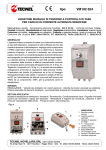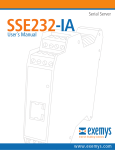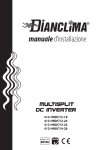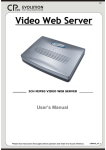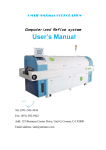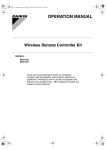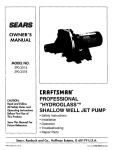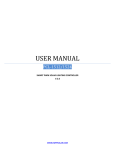Download MPP Solar PIP-MS 1-5KVA User manual
Transcript
USER MANUAL PIP-LC Series 800W~11KW V 1.3 WWW.MPPSOLAR.COM TABLE OF CONTENTS A. INTRODUCTION ...................................................................................................1 A-1 Description.........................................................................................................1 A-2 Features..............................................................................................................2 A-3 Appearance .......................................................................................................3 A-3-1 Front Panel ..........................................................................................3 A-3-2 Outline...................................................................................................4 B. INSTALLATION.......................................................................................................8 B-1 Safety..................................................................................................................8 B-1-1 Positioning............................................................................................8 B-1-2 Transporting ........................................................................................9 B-1-3 Installation............................................................................................9 B-1-4 Operation..............................................................................................9 B-1-5 Maintenance and Service ..................................................................9 B-2 Mounting ...........................................................................................................10 B-3 Wiring .................................................................................................................11 B-3-1 Inspection .............................................................................................11 B-3-2 Connection ...........................................................................................11 C. OPERATION ...........................................................................................................15 C-1 Prior to Startup..................................................................................................15 C-2 Operations Procedures......................................................................................15 C-3 Operation Modes.................................................................................................16 C-3-1 System Block Diagram.........................................................................16 C-3-2 AC Priority / AC Mode...........................................................................16 C-3-3 DC Priority / Inverter Mode………..........................................................16 C-3-4 Battery Mode…….....................................................................................17 D. SYSTEM STATUS & SETTING .............................................................................18 D-1 Output Voltage & Frequency Adjustment.........................................................20 D-2 Charging Current / Battery AH Adjustment......................................................21 D-3 New LCD Menu Setting.........................................................................................22 E. SPECIFICATION .........................................................................................................23 E-1 Other Useful Information ………………………………………………………………………..25 F. TROUBLESHOOTING ...............................................................................................27 F-1 Common Error Codes ………………………………………………………………………………27 A. INTRODUCTION A-1 DESCRIPTION The PIP-LC series is designed to have access to dual input source; one is AC source from a grid, and the other is DC source from a solar array. This series is a powerful all-in-one solution, not only delivering unsurpassed clean true sine wave output power and combining this with a selectable multistage battery charging current but also converting sunlight into clean energy. This series features durable and continuous 24-hour operation. Consequently, it is applicable to any kind of loads such as air conditioner, home appliances, consumer electronic and office equipment. The built-in 5-stage intelligent charger automatically charges any type of batteries without the risk of overcharge. The compact and modular design makes utility interactive installations easier and more cost effective. It is a high quality product that offers the best price-performance ratio in the industry. *SPLIT PHASE version: version standard PIP-LC series comes in single phase 110V or 220V models, except for 8kw or larger which is only available in 220V. For US/Canadian customers or countries that use both 110V/220V loads, Split Phase versions may be special ordered; these are available only in 4kw (24v) and 6kw (48v) at the moment. For more information, please see “A-2 FEATURES”. 1 A-2 FEATURES 1. Multiple microprocessor design base 2. Compatible with both linear and non-linear load 3. Battery size support up to 600AH* (*based on C/10 charging rate at 60A charging current, though larger sized batteries can still be used). System design is based on leadlead-acid batteries only. only 4. 24-hour inverter operation 5. DC start and automatic self-diagnostic function 6. THD less than 3% 7. High efficiency design to save electricity; low heat dissipation in extended operation 8. Designed to operate under harsh environment 9. 3U 19” wall-mounted design 10. Solar power charger with maximum 50A from an array 11. Detachable front panel for remote monitoring (via RJ45 straight-through network cable only) Single-Phase Version (Standard) Single phase models come in either 110V or 220V both input and output terminal will have 1L and 1N, as shown below: G L N N L Split-Phase Version (only available on 4kw and 6kw models) Split phase models accept input of 220V only (L-N) but will have an additional L on the output terminal, so a L-N-L is available for connecting either 110V (using 1L) or 220V (using both L). Most countries that use both 110V/220V would have 2 hotwires of 110V of opposite phase to each other, forming 220V. Split phase model’s terminal would appear as below: Output G L2 N Input L1 2 N L A-3 APPEARANCE A-3-1 Front Panel 1. LCD Display: Display This indicates the PIP-LC operation information, including PIP-LC status, input/output voltage, input/output frequency, battery voltage, battery capacity left, output load, inside temperature, and the times of history events. Up--key key: Use to navigate upward in the LCD menu of PIP-LC. 2. Up Down--key key: Use to navigate downward in the LCD menu of PIP-LC. 3. Down *Holding this button down simultaneously with the Up-key will switch off the PIP-LC. 4. EnterEnter-Key: Key This button is used to key in and confirm data input in the PIP-LC. *Holding this button down with Down-key will switch on the PIP-LC. *In battery operation mode, press this button with Up-key simultaneously will disable the buzzer. (red): To indicate the PIP-LC is in fault condition because of PIP-LC shutdown or 5. Fault LED (red) over-temperature. 6. Warning LED (yellow): To indicate the PIP-LC in the status of overload, bypass and battery back-up. Please note warning LED will also light up when inverter switches to battery power under AC mode (power outage), or when inverter switches to AC power under DC mode (battery low). (green): To indicate the PIP-LC operating normally. 7. Normal LED (green) SYSTEM TEST/MUTE TEST/MUTE key: key Up-key and Enter-key are pressed simultaneously to mute system buzzers under normal conditions. However if overload or critical conditions occur these alarms cannot be disabled. 3 A-3-1 Outline 800W Wall Mounted Type 4 1.6KW/2.4KW Wall Mounted Type 5 4KW / 6KW / 8KW Wall Mounted Type 6 11KW Wall Mounted Type 7 B. INSTALLATION B-1 SAFETY B-1-1 Positioning 1. Do not put the PIP-LC on rugged or declined surface. 2. Do not install the PIP-LC system near water or in damp environments. 3. Do not install the PIP-LC system where it will be exposed to direct sunlight or heat. 4. Do not block ventilation openings in the PIP-LC system or leave objects on top of the PIP-LC. 5. Keep the PIP-LC far away from heat-emitting sources. 6. Do not expose it to corrosive gas. 7. Ambient temperature: 0°C - 40°C 8. Do not position the PIP-LC upside down. 9. Do not position the PIP-LC where debris such as dust can easily accumulate 10. The PIP-LC should be positioned indoors where people can not touch it accidentally because of potential skin burns caused from high operating temperatures. 11. The PIP-LC requires at least 30 cm of space clearance from both the top and the bottom for thermal dissipation. 8 B-1-2 Transporting 1. Disconnect all power cables if necessary. 2. Be careful not to drop/damage the PIP-LC while transporting. 3. Don‘t move the PIP-LC upside down. 4. Please transport the PIP-LC system only in the original packaging (to protect against shock and impact). B-1-3 Installation 1. Connect the PIP-LC system only to a grounded shockproof wiring system to avoid electric shocks resulting from current leakage. 2. Place cables in such a way that no one can step or trip over them. 3. Keep wire lengths between the array and the PIP-LC as short as possible to minimize voltage losses. 4. The installation must be performed by qualified personnel. B-1-4 Operation Do not disconnect the main cable on the PIP-LC system or the building wiring socket outlet 1. during operation. This would cancel the protective grounding of the PIP-LC system and of all connected loads. 2. The PIP-LC has its own internal power source (capacitors). The output terminals may be live even when the PIP-LC is not connected to the AC supply. 3. Ensure that no fluids or other foreign objects enter the PIP-LC system. 4. Disconnect input power in rear panel if you will not use it for long period. If the PIP-LC is stored over 3 months, please supply power to the PIP-LC for at least 24 hours to ensure battery fully recharged. 5. Do not wear any jewelry or metallic objects when working with battery bank. B-1-5 Maintenance and Service 1. Caution - risk of electric shock. Even after the unit is disconnected from the main power supply (building wiring socket outlet), components inside the PIP-LC system are still connected to the battery and are still electrically live and dangerous. Before carrying out any kind of servicing and/or maintenance, disconnect the batteries and verify that no current is present. 2. Batteries may cause electric shock and have a high short-circuit current. Please take the precautionary measures specified below and any other measures necessary when working with batteries: - remove wristwatches, rings and other metal objects - use only tools with insulated grips and handles. 9 B-2 MOUNTING 1. 2. Make sure a wall surface or a solid place can support the PIP-LC. Mark the bracket hole positions of the PIP-LC on the wall. 3. Use a screw driver to fix the PIP-LC 4. If more holes are required to be drilled on the bracket, make sure no metal shavings are left inside the PIP-LC. It could result in a short circuit when PIP-LC is operating. Hole Diameter 800W~2400W 4000W~8000W Upper Hole 9.5mm 15mm Lower Hole 7mm 10mm 10 B-3 WIRING B-3-1 Inspection 1. The system may be installed and wired only by qualified electricians in accordance with applicable safety regulations. 2. When installing the electrical wiring, please note the nominal amperage of your incoming feeder. 3. Inspect the packaging carton and its content for damage. Please inform your shipper immediately should you find signs of damage. Please keep original packaging in a safe space for future use. 4. Please ensure that incoming feeder is isolated and secured to prevent it from being switched back again. B-3-2 Connection Connection 1. Grounding -AC and DC Grounding: The PIP-LC has to be connected to a grounded permanent wiring system; and the array has to be grounded as well. AC and DC are separately grounded. 2. AC Input / Output Terminals -Utility (Input): Recommended AC wire size: Capacity \ Input voltage 100/110/120V 220/230/240V 800W AWG 12 / 3.5mm2 AWG 12 / 3.5mm2 1.6KW AWG 12 / 3.5mm2 AWG 12 / 3.5mm2 2.4KW AWG 10 / 5.5mm2 AWG 12 / 3.5mm2 4.0KW AWG 6 / 14 mm2 AWG 10 / 5.5mm2 6.0KW AWG 4 / 22 mm2 AWG 8 / 8.0 mm2 8.0KW N/A AWG 6 / 14 mm2 11.0KW N/A AWG 4 / 22 mm2 100/110/120V 220/230/240V -Load (Output): Recommended AC wire size: Capacity \ Input voltage 800W AWG 12 / 3.5mm2 AWG 12 / 3.5mm2 1.6KW AWG 12 / 3.5mm2 AWG 12 / 3.5mm2 2.4KW AWG 10 / 5.5mm2 AWG 12 / 3.5mm2 4.0KW AWG 6 / 14 mm2 AWG 10 / 5.5mm2 6.0KW AWG 4 / 22 mm2 AWG 8 / 8.0 mm2 8.0KW N/A AWG 6 / 14 mm2 11.0KW N/A AWG 4 / 22 mm2 NOTE: each recommended wire size above applies to EACH of L/N/G inside a power cable. 11 3. DC Input Terminals - Array (Input): * Make sure the open circuit voltage (Voc) of the PV array is less than the DC maximum input voltage and the short circuit (Isc) is less than the DC maximum charging current of the built-in solar charge controller. See SPECIFICATION for more details. Recommended DC wire size for PV input: Capacity Size 800W 1.6KW 2.4KW 5.5mm2 (AWG 10) 4.0KW 6.0KW 8.0KW * Make sure electric polarity is correct when connecting DC terminals. WARNING: Incorrect electric polar connection will damage the PIP-LC! * Whenever a PV array is exposed to sunlight, it converts sunlight into electric power and results in shock hazard at its output wires and terminals. To avoid the risk of shock, DO NOT leave open wires unattended and cover the array with an opaque material before wiring connections. - Solar Connector *Solar connector is affixed 2 cables with Tyco terminals compatible with output terminals of a module’s junction box. 12 4. Fuses and breakers: Properly sized fuses and breakers should be installed between each important junctions, i.e. PV <-> Controller, Controller <-> Battery, Battery <-> Inverter, and Inverter <-> AC loads. As a general rule of thumb, follow the formula below when selecting a properly sized fuse/breaker: Amp = 1.25 * Isc of ccircuit ircuit current For more information, please consult your electrician for guidance. 5. Communication and Remote Monitoring: Remote monitoring can be achieved by connecting the detached LCD module to the remote control port with ONLY straightstraight-through 11-toto-1 RJ45 cable. cable * DO NOT use cross-over or any other type RJ45 cable as this can cause monitor to function incorrectly or cause damage! 6. Battery: Connect the battery terminals to the battery terminals on PIP-LC and make sure polarity is correct! WARNING: incorrect polarity may blow fuse and cause internal damage to inverter. Recommended battery wire size: Model Max Current Wire Size 800W 67amp AWG 4 1.6KW 67amp AWG 4 2.4KW 100amp AWG 2 4.0KW 167amp AWG 00 6.0KW 125amp AWG 0 8.0KW 167amp AWG 00 NOTE: for 6KW/8KW inverters, battery resistor cable (see below) may be included for your convenience. Be sure to apply it in between the battery and inverter for at least 5 seconds before directly connecting the battery to your inverter terminal. This will help reduce the sparks during 13 connection. * Inverter may be turned OFF, but can still carry live electricity. WARNING: if you intend to service the inverter, please ensure all power sources (AC, battery etc) are all disconnected. Also, capacitors inside the inverter may still carry charge and it is strongly disconnected recommended that the capacitors are first discharged before working with internal PCBs to avoid damage to system. The above battery resistor can be used to discharge the capacitors. 7. System Schematic Concept: 14 C. OPERATION C-1 PRIOR TO STARTUP 1. Ensure the PIP-LC is in a suitable positioning. 2. Check and ensure all inputs cables are secured. 3. Make sure the load is disconnected or in the “OFF” position. 4. Check if input voltage meets the PIP-LC rating required. 5. Ensure batteries, loads (turned off), and AC cables are properly connected before switching on the PIP-LC. C-2 OPERATIONS OPERATIONS PROCEDURES Please follow the instructions below for PIP-LC operation. 1. Connect AC source (optional). *This inverter requires DC power to start, and AC is optional. 2. By pressing the Enter Enter--key and the Down Down--key simultaneously for about 3 seconds seconds, system greetings will display and inverter will start up after two beeps and Normal LED lights up to indicate the power is from its bypass AC main to the load. 3. When the DownDown-key and the UpUp-key are pressed simultaneously for 3 seconds, seconds the PIP-LC will be turned off after two beeps. The system will remain in standby mode (Normal LED will keep blinking) until AC input is completely disconnected. 15 C-3 OPERATION MODES C-3-1 PIPPIP-LC System Block Diagram C-3-2 AC Priority / AC Mode System default is AC priority mode. There are two main loops when AC utility is normal: the AC loop and the battery charging loop. The AC output power comes from AC utility input and passes through static switch to support power to load. The battery charging voltage comes from AC utility input and converted by AC/DC charger to support battery-charging power. If solar power is sufficient, the solar charger (optional) will also provide charging power to battery. C-3-3 DC Priority Mode / Inverter Mode A new feature of the system provides the option for users to change in the LCD from “AC priority / AC Mode” to “DC Priority / Inverter mode”. In this mode, DC power will be priority and system will draw power from battery whenever possible. When battery is low, system will automatically switch to AC for quick boost charging to 14.5V and left on float at 14V for 2 hours before it switches back to DC mode again. If AC power is unavailable the system will enter Battery mode. Solar charging will remain in operation whenever possible (minimum working voltage 11.7V±0.5V@12V). 16 C-3-4 Battery Mode (AC utility failure) When there is insufficient solar power and AC power is unavailable, the system will enter Battery mode. In this mode the PIP-LC will convert all power from battery bank into usable AC electricity, thereby supplying power to loads. 17 D. SYSTEM STATUS This section contains information on the system status that can be displayed via PIP-LC’s LCD screen. Use Up/Down key to select/display various system parameters as shown in LCD below. This screen will refresh once the system power is enabled. Input / Output Power Spec System Mode & Status Input / Output Voltage Input / Output Frequency 18 Battery Voltage and Capacity Output Power System Temperature History Record 19 D-1 OUTPUT VOLTAGE & FREQUENCY ADJUSTMENT After PIP-LC startup, press the Down-key to find the screen and then press Enter-key for setting. In this screen, press Enter-key to enter the following steps for output voltage and frequency adjustment. The cursor (→) will pop up to indicate the output voltage and frequency newly selected. Use Up or Down-key to adjust the output voltage (if 220V configure, 220V, 230V, and 240V is selectable; if 110V configure, 110V, 115V, and 120V is selectable). Press Enter-key to confirm voltage and then the cursor will move to frequency selection. The output frequency (50Hz or 60Hz) can be adjusted by the same key operation. Once the correct voltage is selected, press Enter-key again to save the selection. 20 D-2 CHARGING CURRENT CURRENT / BATTERY AH ADJUSTMENT (for prepre-2011 models) models)* In this screen, press Enter-key to enter the following steps for general battery AH adjustment. The cursor (→) will pop up to indicate the battery AH newly selected. Use Up or Down-key to select the battery AH (100AH, 200AH, 300AH, 400AH, and 600AH selectable). Press Enter-key to confirm your battery AH. Once the correct battery AH is selected, press Enter-key again to save the selection. *NOTE: this setting is for models pre-2011 only. Charging current adjustment has now been simplified to Low-Med-High Setting. Please see “D-3 NEW ADDITIONAL LCD MENU SETTING” for more detail. 21 D-3 NEW ADDITIONAL LCD MENU SETTINGS I / P Voltage Range Setting Default : Input Voltage : LO = 170V,HI = 270V. Input Frequency : 45Hz~ 70Hz LO : 120V ~ 200V( One Touch: +/- 1V) HI : 250V ~ 280V( One Touch: +/- 1V) 1. Return point= +/_ 10V from the transfer point. 2. Press Enter to enable the setting. No need to re-start the inverter. O/P Voltage /Frequency Setting Default: 220VAC , 50HZ Voltage: 220VAC / 230VAC / 240VAC Selectable Frequency: AC= Synchronized to AC., DC= 50HZ / 60HZ Selectable Press Enter to confirm. *NEED TO RESTART INVERTER. AC/DC Prior Setting Functioning only under AC Mode. *This feature requires minimum 24V. Default: AC Prior. Select "AC MODE" for AC Prior ., "INVERTER MODE" for DC Prior. 1. Under “DC Prior” if battery voltage is too low, it will auto change to AC if AC normal. 2. Press Enter to confirm. *NEED TO RESTART INVERTER. Battery Shutdown Voltage & Current Setting ( 48V/ 24V) Default: 40V(20V). HIGH: 42V ( 21V)/ MIDDLE: 40V ( 20V) / LOW :38V ( 19V) Selectable 1. Low Voltage warning point: 42.5 V( 21.5V) 2. Press Enter to enable the setting. No need to re-start the inverter. Battery Charging Current Setting Default: Middle LOW ( 100AH) - MIDDLE ( 300AH) - HIGH ( 600AH) Press Enter to enable the setting. No need to re-start the inverter. (OPTIONAL, (OPTIONAL, extra charge) charge) Green Power On/Off Setting *Requires minimum 24V & only under Inverter Mode. Default: Off. Green Power Off: System running continuously. Green Power On: System Auto Shutdown when Load < Pre-setting Press Enter to enable the setting. No need to re-start the inverter. (OPTIONAL, (OPTIONAL, extra charge) charge) Green Power Mode & Time Setting *Requires minimum 24V. Default: Time period for next detecting: 30 Sec. Time: 15 Sec., 30 Sec., 45 Sec. 60 Sec selectable. 1. Detecting load: ~20w 2. When the load is less than 20w,the inverter will auto turn off and count the pre-set time ( 30 Sec.), then, re-start. 3. Press Enter to enable the setting. No need to re-start the inverter. 22 E. SPECIFICATIONS Model Capacity VA / Watt PIPPIP-812LC PIPPIP-1624LC PIPPIP-2424LC 1.2KVA / 800W 2.4KVA / 1600W 3.6KVA / 2400W Nominal Voltage 220Vac; 110Vac Range Input 120-275Vac ; 60-135Vac Frequency 50Hz / 60Hz Line Low Transfer 120VAC ± 2% ; 60VAC ± 2% Voltage Acceptable Voltage Range Line Low Return 130VAC ± 2% ; 65VAC ± 2% Line High Transfer 275VAC ± 2% ; 135VAC ± 2% Line High Return 260VAC ± 2% ; 130VAC ± 2% Voltage 110/115/120VAC or 220/230/240VAC resettable via LCD panel) Voltage Regulation (Battery Mode) < 3% RMS for entire battery voltage range Frequency 50Hz or 60Hz Frequency Regulation (Battery Output ±0.1Hz Mode) Power Factor 0.8 Waveform Pure Sine Wave Peak Efficiency Transfer Time ( 45Hz - 70Hz) Overload Line Mode Protection Battery Mode 80% Circuit Breaker 110% ~ 150% for 30 sec. , >150% for 200ms Typical Battery Voltage 85% < 8 ms. 12Vdc 24Vdc 24Vdc Battery Max. Charging Current > 40A > 50A INVERTER status, I/P&O/P Voltage Frequency, Load%, LCD Display LCD Battery Voltage/%, Charge current, Temperature, Model LED Normal (Green), Warning (Yellow), Fault (Red) Battery Mode Beeping every 4 seconds Low Battery Beeping every second Inverter Fault Beeping Continuously Audible Alarm Overload Beeping twice per second Operation Temperature Environment 0-40 degree C; 32-104 degree F Relative Humidity 0-95% non-condensing Audible Noise Net Weigh (Kgs) Less than 55dBA (at 1M) 14 21 23 298*400*150 298*450*190 298*450*190 Physical L*W*H (mm) * Specifications are subjected to change without prior notice. 23 Model Capacity VA / Watt PIPPIP-4024LC PIPPIP-6048LC PIPPIP-8048LC PIPPIP-11048LC 5KVA / 4000W 6KVA / 6000W 8KVA / 8000W 8KVA / 8000W Nominal Voltage Voltage Range Input Acceptable Voltage Range Frequency Line Low Transfer 220Vac only 120-275Vac ; 60-135Vac 120-275Vac 50Hz / 60Hz 120VAC ± 2% ; 60VAC ± 2% Line Low Return Line High Transfer Line High Return Voltage Output 220Vac; 110Vac Voltage Regulation (Battery Mode) Frequency Frequency Regulation (Battery Mode) Power Factor Waveform Transfer Time 85% (90% with Green Power Mode) Line Mode Circuit Breaker Battery Mode 110% ~ 150% for 30 sec. , >150% for 200ms Typical Battery Voltage Battery 120VAC ± 2% 130VAC ± 2% ; 65VAC ± 2% 130VAC ± 2% 275VAC ± 2% ; 135VAC ± 2% 275VAC ± 2% 260VAC ± 2% ; 130VAC ± 2% 260VAC ± 2% 110/115/120 or 220/230/240VAC 220/230/240VAC adjustable via LCD adjustable via LCD < 3% RMS for entire battery voltage range 50Hz or 60Hz ±0.1Hz 0.8 1.0 Pure Sine Wave Peak Efficiency Overload Protection ( 45Hz - 70Hz) < 8 ms. 24Vdc 48Vdc Max. Charging Current > 60A > 85A INVERTER status, I/P&O/P Voltage Frequency, Load%, Battery Voltage & %, Charge LCD current, Temperature, Model Display LCD Audible Alarm LED Battery Mode Normal (Green), Warning (Yellow), Fault (Red) Beeping every 4 seconds Low Battery Beeping every second INVERTER Fault Beeping Continuously Overload Operation Temperature Beeping twice per second 0-40 degree C; 32-104 degree F Environment Physical Relative Humidity Audible Noise Net Weigh (Kgs) L*W*H (mm) 0-95% non-condensing 49.2 415*600*260 Less than 55dBA (at 1M) 51.4 53.6 415*600*260 415*600*260 110.4 452*670*277 * Specifications are subjected to change without prior notice. OPTIONAL BUILT-IN SOLAR CHARGE CONTROLLER Battery/System Voltage 12V (800W) 24V (1.6~4KW) 48V (6~11KW) (6~11KW) 13.8V 27.7V 55.2V 11.7V±0.5V 23.5V±1V 44V±3V Max Solar Input Voltage 22.0V 45.0V 100V Max Solar Input Current 50A 50A 50A Max. Charging Current 50A 50A 50A Reverse Polarity Protection YES YES YES Reverse Current Protection YES YES YES Charging Voltage Minimum Solar Working Voltage W*D*H 112mm * 80mm * 50mm *Please ensure PV input voltage and current do not exceed above input specifications. 24 E-1 OTHER USEFUL INFORMATION 1. Battery Voltage Alarm & Shutdown Battery Voltage. Battery Low Alarm Battery Low Shutdown DC range 12V 10.8V 10.3V 10.5V~14.5Vdc 24V 21.5V 20.0V 20V~29.3Vdc 48V 42.5V ~ 43.0V 40.0V 40V~58.5Vdc 2. High Temperature FAULT alarm System Internal temperature 60°C Heat Sink temperature 80°C 3. Inverter Inrush Current: Model Name Inrush Current (220Vac, 5 cycles) Inrush Current = KVA 812LC 9.5A 2.1KVA 1624LC 19A 4.2KVA 2424LC 24.5A 5.4KVA 4024LC 33A 7.2KVA 6048LC 72A 15.8KVA 8048LC 84A 18.5KVA **Maximum surge is purposely lowered for operational safety and stability. 4. System Current Consumption (with & without Optional Green Power Mode) Mode) Note: this feature will activate when load is <~20w. Values below are approximate based on average. Without Green Power Mode With Green Power Mode 812LC 3.6A (reference) < 0.63 A 1624LC 2.6A (reference) < 0.42A 2424LC 3.2A (reference) < 0.42A 4024LC 3.8A (reference) < 0.63A 6048LC 2.7A (reference) < 0.42A 8048LC 3.8A (reference) < 0.42A 5. Circuit Breaker Rating (Based on 220v) 812LC 8A 1624LC 8A 2424LC 20A 4024LC 30A 6048LC 40A 8048LC 40A 25 5. Inverter Charging Voltage Chart Under DC priority (Inverter mode), the inverter will transfer to AC line mode after the battery low shutdown. And then the AC power continues to charge the batteries. When the batteries are boost-charged up to the highest voltage like the A point (14.5/29.3/58.5Vdc) in the drawing, the inverter will start to count count for 2 hours and then it can back to inverter mode again. 26 F. TROUBLESHOOTING The following guideline may be helpful for basic problem solving. No. INVERTER STATUS POSSIBLE CAUSE AC utility power is normal. NVERTER is 1 3 Charger PCB is 1. Replace the charger PCB. damaged. 2. Replace the fan. 2. Fan is damaged. 3. Restart INVERTER 3. Unknown 1. running normally, but fault LED lights up. Buzzer beeps continuously. ACTION AC utility power is normal but INVERTER is Overload Please reduce the critical load to overloaded. Warning LED lights up and 100%< load< 125% <100%. AC utility power is normal. Warning LED does Overload Please reduce the critical load to not fade out and buzzer beeps per 0.5 125%< load<150% <100%. AC utility power is normal. Warning LED Overload Please reduce the critical load to lights up and buzzer beeps continuously. 150%< load <100%. AC utility power fails .The load is supplied by 1. AC utility power 1. Reduce the less critical load in buzzer beeps per second. 4 second. 5 battery power. Buzzer alarm sounds every 4 6 failure. seconds. order to extend backup time. 2. AC input connection 2. Please check the rated input or may be not correct. 7 connected line. AC utility fails. INVERTER is in battery backup Battery power is INVERTER will shut down mode. Buzzer alarm beeps every second. approaching low level. automatically. Please save data or turn off the loads soon. AC utility power fails. INVERTER has shut 8 Battery runs out INVERTER will restart up when AC down automatically. utility power is restored. F-1 COMMON ERROR CODES please do not attempt to engage selfself-repair or replacement of internal PCBs without prior authorization as this will avoid warranty! Contact your seller for further instruction. Problems AC Abnormal LCD Display I/P Polarity ERR Solutions Check(Only 120V Series) : AC INPUT N – GND VOL > 1V Solutions : Improve the grounding of AC main. 27 AC Fail Check : (Under inverter mode, but can not transfer to line mode.) a. AC Voltage : *** 60V > AC Voltage > 135V (120V Series) *** 120V > AC Voltage > 270V (220V Series) b. AC Frequency : *** 45Hz > AC Frequency > 70Hz If no, replace control & Main PCB. DC Abnormal DC_BUS Fail Check : (Battery Voltage) *** 1.2K : Battery Voltage > 15.0V *** 2.4K / 3.6K / 5K : Battery Voltage > 30.0V *** 6K / 8K : Battery Voltage > 60.0V If no, replace battery. Charger Fail Check : (Charger Voltage) *** 1.2K : 11.2V > CHG. VOL > 15V *** 2.4K / 3.6K / 5K : 22.5V > CHG. VOL > 30V *** 6K / 8K : 45V > CHG. VOL > 60V Solutions : (OFF (OFF AC) *** Under cold start, if Inverter Mode OK, replace the Control PCB *** Under cold start, if Inverter Mode N.G., replace control & Main PCB Over Temperature Temp Fail Check : *** If The Temperature Of the inverter is really high *** Remove Some Unnecessary Loads *** That The Fan is Normal *** The Temperature Sensor Circuit.. Solutions : *** Restart the inverter. If N.G., replace the control PCB Fan Abnormal Fan Fail Check : *** That The Fan is Normal *** The Fan’s Sensor Circuit. Solutions : *** Restart the inverter. If N.G., replace the control & main PCB Over Load Over Load Check : *** If LCD Display Output Power > 110 % *** Remove Some Unnecessary Loads to be Less Than 90% *** Restart the inverter to Enter Into the Inverter mode 28 Inverter Abnormal Inverter Fail *** Remove the load Check : *** 1.2K ~ 3.6K Check PSDR Board DC Fuse Damaged; *** 5K ~ 8K :Check Fuse Board DC Fuse Damaged; *** Check if power PCB is damaged.. Solutions : *** If DC Fuse or Power Components Damaged, Please replace the main PCB *** If no damaged, the inverter may be output shorted or output inrush current cause the inverter protection. Please restart the inverter. Can’t Cold Start Check : a. LCD Display Panel : *** Check it LCD Display Panel is connected or inserted properly. b. Battery Voltage (for initial start and auto auto restart) : 1.2K : 10.5V > Batt. VOL 2.4K / 3.6K / 5K : 21.5V > Batt. VOL 6K / 8K : 40V > Batt. VOL Solutions : *** Replace the battery 29































